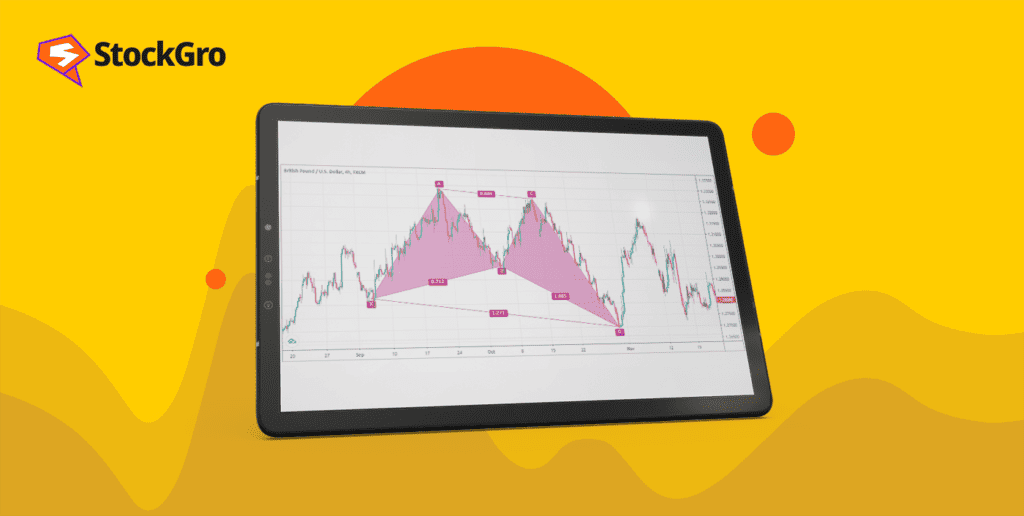
When learning technical analysis, the most fundamental skill for any trader to develop is the ability to recognise patterns in charts. Several chart patterns are used to pinpoint a particular trend.
However, staying confident enough to do independent technical analysis is essential if you want to make the most efficient and profitable trading choices.
One kind of chart pattern used in trading strategies is the harmonic pattern. They help traders recognise price patterns by forecasting future movements in the market.
In today’s article, we will talk about this Fibonacci-sequence-based pattern in detail, along with its many types and their uses. Stay tuned!
Also read: Do all technical analysis tools work equally well?
What are harmonic patterns?
H.M. Gartley developed the idea of harmonic chart patterns, which is mentioned in his book Profits in the Stock Market. Gartley discussed a 5-point pattern which he called the Gartley pattern.
Harmonic trading patterns use Fibonacci numbers to generate geometric price patterns and spot possible price shifts or trend reversals. By keeping an eye out for these trends, traders can more effectively predict their next move.
Using mathematics and patterns, harmonic trading develops a highly accurate trading strategy predicated on the idea that certain patterns tend to repeat. The technique’s central idea is the primary ratio or any derivation of it.
Among the most effective and profitable trading patterns are harmonic patterns. Despite being more intricate than other patterns, they may help technical analysts understand further market price action data.
Also read: Here’s how you can use the MACD indicator
Top 5 types of harmonic patterns
- Bat harmonic pattern
Scott Carney discovered the bat pattern at the very beginning of the 2000s. The term “bat” comes from the complete bat-shaped structure.
When a trend temporarily changes course before continuing in its original path, it forms the Bat pattern, which is a retracement and continuation pattern. Traders might take advantage of this pattern to enter a trend at a profit.
Similar to other harmonic patterns, there can be bullish and bearish bat patterns, as we can see in the image.
In general, the bat pattern follows these guidelines:
- The AB leg can retrace 38.2% to 50% of the XA leg.
- The amount of the AB leg that the BC leg may retrace ranges from 38.2% to 88.6%.
- The CD leg has a maximum retracement range of 88.6% of the XA leg.
- Alternatively, the CD leg can be an extension of the AB leg, ranging from 16.18% to 26.18%.
- Cypher harmonic pattern
The cypher harmonic pattern has four waves, or legs, dividing its five contact points. Each leg shows a price action, and every touchpoint denotes a reversal level. It has a steeper appearance because it uses tighter Fibonacci ratios, often less than 1.
Cypher patterns must follow the following guidelines:
- AB retraces from 38.2% to 61.8% of XA.
- The distance from point A to point C is 127.2% to 141.4%.
- Point D doesn’t go more than 78.6% past point X.
- Shark harmonic patterns
Relatively new to the field of technical analysis, the shark harmonic pattern was identified by Scott Carney. Shark patterns are used for predicting possible market reversal points. It is a variant of the more widely used Butterfly, Bat, and Gartley structures.
The framework consists of four legs and five separate swing points. Scott decided to use O, X, A, B, and C as point labels rather than the typical X, A, B, C, and D used by other patterns. This indicates that traders try to enter at C instead of D.
The shark, like other harmonic patterns, needs certain Fibonacci ratios to be satisfied to be accepted for trading. The shark differs from other trading systems, however, in that it uses the 88.6% and 113% ratios to pinpoint possible reversal points.
Also read: A comprehensive guide to reversal candlestick patterns
- Butterfly harmonic pattern
Reversal patterns such as the butterfly harmonic pattern often emerge at the end of a trend move. Composed of the numbers X, A, B, C, and D, it was created by Bryce Gilmore. This pattern has two variations: bearish butterflies indicate when traders should sell, while bullish butterflies indicate when they should purchase.
Follow these guidelines to create the butterfly pattern:
- If the butterfly pattern is correct, the B point should retrace 78.6% of the XA leg, making it the most crucial level.
- It is expected that the BC move will retrace the AB move at 38.2% or 88.6%.
- Assuming BC accounts for 38.2% of AB, CD is projected to extend to 161.8% of BC. Conversely, if BC is 88.6% of AB, CD is probably going to reach the 261.8% extension of BC.
- D has to be an extension of XA of either 127.0% or 161.8%.
- Gartley harmonic pattern
Gartley patterns usually appear during a trend correction. Bearish Gartley patterns are W-shaped, while bearish patterns form an ‘M’.
HM Gartley created the Gartley pattern, which has two basic rules:
- Point B’s retracement has to be 0.618 of XA.
- At Point D, the XA movement should retrace at a distance of 0.786.
Point B’s retracement has to be exactly 0.618 of XA, much like the BAT pattern. The XA leg causes a BC retracement. It is common practice to set a stop-loss at point X and a take-profit at point C.
Pros and cons of harmonic patterns
Perks:
- These are leading indicators because they provide predictions and deadlines ahead of time.
- These patterns are dependable, consistent, frequent, and likely to yield setups
- Fibonacci ratios are used to partially standardise trading practices.
- Perform across various market time frames and asset classes
- They may be used in conjunction with other indicator concepts (RSI, MACD, etc.).
Drawbacks:
- Complex and highly sophisticated, making interpretation challenging.
- It is challenging to identify and automate (code) harmonic patterns accurately.
- It may be difficult to determine reversal or projection zones when there are contradictory Fibonacci retracements or projections.
- When competing patterns emerge from the same or different swings or eras, things become complicated.
Conclusion
When predicting the direction of prices over nearly any time frame, harmonic patterns are extremely reliable. But even though this is a precise and mathematical approach to trading, mastering these patterns takes a great deal of research, work, and dedication to succeed.

